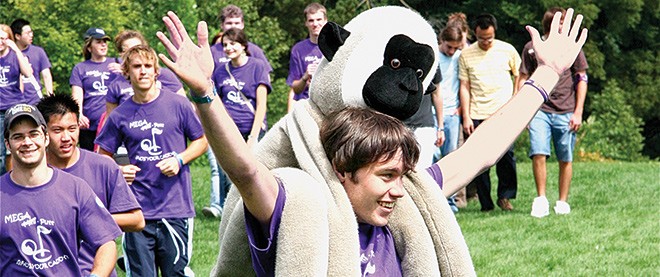Alcohol-free frosh weeks have failed
Why some universities focus on harm reduction instead
Share

The University of Western Ontario, like other schools, has done its best to separate frosh and alcohol during the first week of school. Booze is banned at school-organized events, and residence leaders sign contracts promising to abstain to set a good example. Student volunteers won’t help move anything packed in liquor-store boxes into residence.
But despite best efforts, alcohol-free frosh weeks across Canada have largely been a failure. The problem is that frosh will be frosh and flout the rules, and we live in a culture where booze is considered essential to a good time.
Within hours of moving in to Saugeen-Maitland Hall in 2012, Bill Wang says Western students were asking each other what they had to drink. Some had even smuggled in booze from home. “It was just a shock,” said Wang, 19, who grew up in a Toronto neighbourhood where drinking was not that popular. “The first thing you hear about is this dry week. Once those doors close, it’s surprising how people disobey.”
Many Ontario universities introduced drinking bans at school-sanctioned socials after the province eliminated Grade 13 in 2003, because most first-year students were underage. Now, more than a decade later, students across the country continue to drink excessively, only, instead of caps, they’re playing Neknominations.
One YouTube video shows Nick Alessi, 19, a Brock University student, standing outside as a friend pours vodka, wine and an energy drink into his mouth from a window three stories above. When Alessi stops screaming that his eyes are burning, he “nominates” two friends to pull similar stunts. “Every single one of my friends has done [Neknominations] now,” says Alessi, who admits to drinking underage in his first year. “It’s widespread throughout the campus.”
Gerald Thomas, a senior research and policy analyst at the Canadian Centre on Substance Abuse, says drinking bans are a heavy-handed approach that can backfire because teenagers don’t like being told what to do and are not deterred by the risks of binge-drinking: brain and liver damage, cardiovascular disease, even death. (Two students died in alcohol-related accidents at Queen’s University in 2010; a coroner’s report refererred to a “culture of drinking.” One year later, an Acadia University student died after binge-drinking during a team game called “flip cup.”)
“My sense is that the drive to ban alcohol use among first-year students in universities is as much a liability issue as anything, because, if they’re going to be drinking in the dorms, the campus may be liable if there are injuries or deaths,” said Thomas.
A 2009 Statistics Canada survey shows that 40 per cent of males and nearly 30 per cent of females aged 18 to 19 are heavy drinkers (defined as consuming five or more drinks at a sitting), the highest proportion in Canada. The problem is that alcohol is not only condoned, but considered a form of recreation, making education an ineffective form of intervention.
Thomas cites Acadia University as a model. Its focus is not prohibition, but harm reduction, said James Sanford, the university’s executive director of student services. Students are encouraged to drink in common rooms, not behind closed doors. The number of bottles they can take in is restricted in order to slow down the pace of consumption. And they are repeatedly asked to seek help if they feel sick. As a result, the university has seen a spike in 911 calls, but fewer transports to hospital. The school also works with bar owners, who can contact campus officials if they are concerned about a student.
Thomas would like to see controls on the number of bars on or near campuses, because availability and price are the best ways to curtail dangerous drinking.
Meanwhile, there is an increasing demand for alcohol-free living, which many residences offer. At Western’s residences, 1,529 students—32 per cent of dwellers—requested alcohol-free floors, an increase from a decade ago, when the school had 545 requests. At McMaster, they have doubled the number of alcohol-free spots to 100 out of roughly 3,600 beds in recent years.
At Western, 21-year-old Burhan Aydar says he faced peer pressure to drink in first year. “You have to really come out of your bounds and do many things that go against your moral code,” said Aydar, a second year bio-medical sciences student who is a Muslim. “As a result, I and many students were put in a very difficult situation of having to reject alcohol and trying to use different methods to get the same result of fitting in.”
Wang, now a residence adviser at Saugeen-Maitland, rarely drinks. “People just go into that mindset where drinking turns them into a different kind of person,” he says. “There are so many other things you can go to other than pub nights.” One of the best ways to find kindred, non-drinking spirits is to join clubs. For Wang, it was the triathlon and business clubs. For Aydar, it was the Muslim Students’ Association, founded by president Amir Hage, 22, who skipped his own orientation week to avoid the drinking scene. Now the MSA holds its own Welcome Week, where students bond over pizza lunches, volleyball and soccer games.